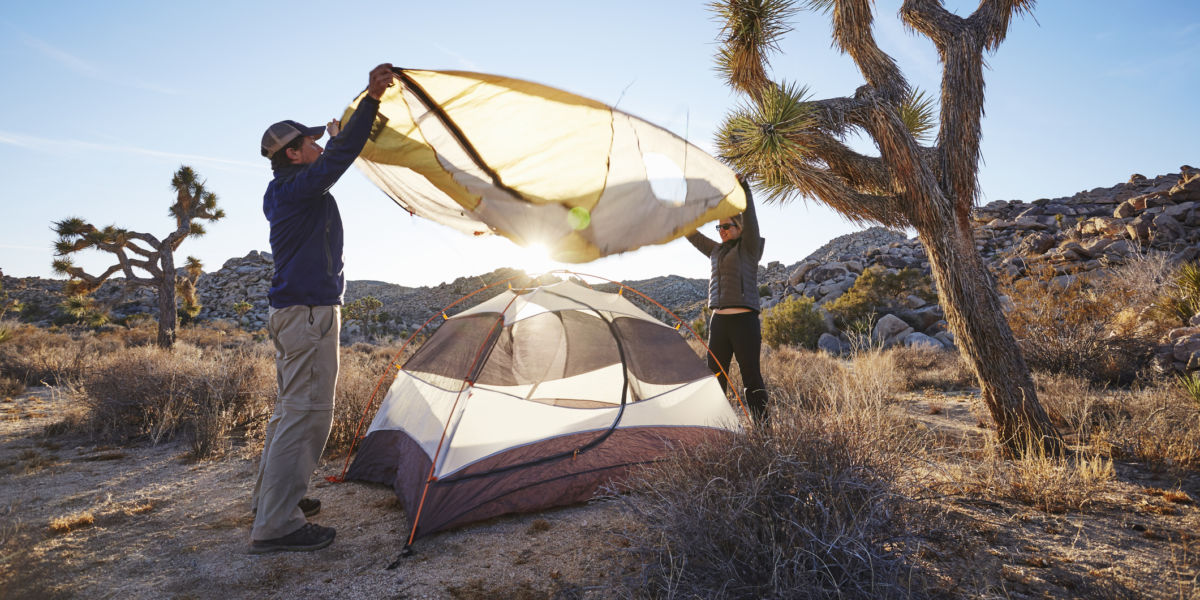
The Dos and Don’ts of Tent Set-up, According to the Bureau of Land Management
The Bureau of Land Management’s “Get Primitive” series is designed to guarantee a successful camp outing.


The concept is simple, but anyone from a novice camper to a seasoned outdoors enthusiast might occasionally slip up when pitching a tent for a night or two of camping.
With warmer weather on the horizon, an influx of camping is once again expected to kick into high gear, especially if last year’s pandemic-fueled camping trends are any indication. Public interest in camping increased exponentially in the months after the nation first locked its doors due to COVID-19, the dread of at-home confinement ushering much of the American public outside.
For anyone interested in joining such a migration, whether as a total beginner or just a tad rusty, the Bureau of Land Management wants to make sure your camping experiences unfold as painlessly (literally) as possible.
“We’re going to break things down for you Barney style to ensure you have the essential skills you need to get away from the crowds and get that much-needed nature respite,” BLM staff wrote.
Before you dive into the pillars of campsite selection, visit the BLM’s “Know Before You Go” page for tips on everything from avoiding poison ivy and ticks to safe practices around wildlife and fire.
Once you’ve set off and lugged your tent into an area you deem host-worthy, there are a few main things to consider.
First, and Perhaps Most Obvious, Finding Flat Ground Is Ideal
“Look for an area that is generally flat with no obvious bumps,” BLM officials suggest. “Grab your sleeping mat out of the car, lay it out, and lay on it for a few minutes to see if any rocks, pine needles or anything else is poking you. Use your foot or a broom to clear away the area you plan to pitch your tent on and then lie down on the ground and scan.”
Easy enough, but even a slight miscalculation can result in a few none-too-friendly body aches the following day that can put a damper on the entire experience.
Next, Determine Your Campsite’s Exposure to the Elements
“When picking the location of your tent, look for natural outcroppings of rocks or high trees that provide shade,” BLM notes. These “natural elements will also provide a level of protection from wind.”
Physical exertion out on trails can make the return trip to the comfort of a cozy tent a most welcome experience, after all. So, it’s best if your humble abode hasn’t been baking in the sun all day.
Lastly, Consider Your Proximity to Both Fire and Water
Setting a tent up right next to a river or creek might sound ideal at first, but with certain regions boasting weather patterns that can change in an instant, it’s best to put a little distance between the water and your shelter.
“When picking your tent’s location, try to keep about 200 feet away from the water’s edge,” the BLM writes. “Not only will this provide you a level of safety in the event of a flash flood, but you’re less likely to accidentally contaminate water sources.”
Similar distance procedures apply to fire as well.
“You want to be close enough to enjoy it, but far enough away so that your tent is not getting smoked out or is a fire risk from flying embers.”
Simple enough, right? Time to put these tips into practice and ensure your campsite remains absent the discomforts a novice mistake can yield.
As for actually assembling the tent? The BLM will soon tackle that as well as part of a “Get Primitive” series designed to dish on all the best tips to guarantee a successful outing.
Want more information on camping on public lands? Visit the Bureau of Land Management’s camping page.
Get outside! And as always, leave no trace.
Read the 2021 Wellness Issue
To read: Click on the right and left arrows at the edge of the box to turn pages; to make the text larger, click on the fullscreen icon in the lower-right corner (desktop) or in the center (mobile).
Get one year of Sunset—and all kinds of bonuses—for just $24.95. Subscribe now!
